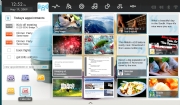Moblin is an Intel-created open-source operating system for netbooks and, specifically, the kind of people who use them.
On a technical level this means Moblin is built for the Atom x86 chip found in many netbooks, while on a practical level it means Moblin is an Internet- and multimedia-focused operating system.
Moblin is less about knocking-up spreadsheets on the move and more about twittering, updating your Facebook account, and watching movies on the go.
Fundamentally, Moblin is just another distribution of Linux (based on Fedora), although it’s one that benefits from some unique tweaks and a radical user-interface. However, traditional apps take a back seat, and some you might expect are missing (there’s no GIMP or OpenOffice.org, for example). Moblin is based on the familiar GNOME/GTK desktop, like distros such as Ubuntu, but this is largely invisible because of the UI improvements.
Any offline functionality tends to be geared around playing movies or music, so you can keep up with The Wire or Britney’s latest while out of range of a wifi base station.
Moblin is open source, and free of charge, so you can download and try it yourself. Like most of Intel’s mainstream processors, the Atom is essentially an x86 chip, so you should be able to run Moblin on any computer, or in a virtualised environment.
However, it requires 3D graphics drivers so is far from optimal in VMware or VirtualBox, and is also optimised for low-resolution widescreen displays. Additionally, its hardware support is deliberately limited to what is usually found in netbook computers.
The first beta of Moblin v2.0 has just been released, and I decided to take a play with it.
Getting Started
The beta nature of this release is very evident and I got off to a bad start. The wifi card in my Dell Mini 9 wasn’t recognized, so I had to review the OS while tethered by a cable to my Internet router. Additionally, I had couldn’t sign into some of the online services, such as Twitter, because the Moblin sign-in software just didn’t work.
Perhaps the biggest bug that stopped me testing Moblin thoroughly was an inability to click in text fields within the browser. I was therefore unable to enter my username/password with online services, such as Gmail or Google Docs, and was unable to test the speed of the browser when accessing applications.
These are severe bugs for a beta release, and render the OS effectively useless, even for those who don’t mind taking on the chin the occasional crash or loss of data.
Incidentally, and perhaps surprisingly, Moblin appears not to know that Google exists. You can setup Google Talk for chatting, but its browser suggests searching Yahoo! by default. Does anybody below the age of 50 still use Yahoo!?
It felt a little like the Moblin developers have backed the wrong horse here. I would have liked to have seen tie-ins with the likes of Gmail and Google Docs. Where’s Google Gears, so my data can be backed up locally?
Moblin includes an actual email client, seemingly based on Evolution, and I found this astonishing. If you’re still in the groove of downloading email to your computer in our modern age then you’re doing it wrong. If you’re downloading it to a portable computer designed to be a secondary computing device then you’ve definitely doing it wrong.
But perhaps I’m getting ahead of myself here. Let’s start with a description of how Moblin looks and feels.
Look and Feel

Put simply, Moblin looks and feels terrific. We’re talking Apple-like levels of attractiveness. Similarly, intuition is the name of the game with the user-interface, and it invites an Apple-like sensibility of following your nose to work out how things work.
Across the top of the screen is a range of icons representing various activities you can do. This is effectively a floating toolbar, because it disappears when you don’t need it.
When the mouse runs over the toolbar, its icons jiggle about in a neat way, a feature provided by the Clutter OpenGL graphics and animation toolkit that underpins the whole OS. This gives everything a fun feel, and reminds you that this is not a business-oriented OS. Moblin is for things you want to do, not things you have to do.

Once you select an icon, its program window pop-out beneath the toolbar. The program window might fill just half of the screen, such as with the Status Update tool by which you can post to Twitter, or it might fill the entire screen, as with the browser.
The Web browser is a good example of the design philosophy and polish applied to Moblin. Click on the browser icon on the main toolbar, and a small panel folds out showing thumbnail previews of your favorite websites.
Alternatively, you can type an address in the relevant field. Once this is done, the browser then takes over the entire window. Along the top of the screen is the address bar, along with a tab bar, but the rest of the screen contains nothing but the website.
Zoned Out

Key to Moblin’s interface philosophy is the concept of zones. However, the term is used in two separate and distinct ways. The first usage is the ‘myzone’. This gets its own toolbar button and effectively provides an aggregated home page where, for want of a better way of saying it, you can see at a glance what’s happening in your online world.
Recent twitters from your friends appear here, as do thumbnail previews of your favourite websites. Calendar and To Do reminders also appear at the left.
The second use of the word is to provide what are effectively virtual desktops, which is a method of overcoming the limitations of small netbook screen sizes. Any application you start must be assigned to an existing zone, or to a new zone.
More than one application can be assigned to a zone, and perhaps this lets you see the benefit – the zone switching tool (which has its own toolbar button) lets you select between not only zones but also applications within a zone. If you’ve ever used any of Mac OS X’s Spaces and Expose features, you’ll already be aware of the overall concept.
It works well, but it’s a little irritating to be prompted to choose a zone to assign the program to upon each program launch. It turns a one-click procedure into a two-click procedure, and also induces confusion in beginners who don’t yet understand the concept of zones.
Far better would be if the application was automatically assigned to a new zone. The zone manager could then be used for the more sensible purpose of aggregating and managing existing program windows.
Criticism
Sometimes Moblin wasn’t entirely intuitive. It would do something strange, leaving me wondering what it’s up to. Why did that program window just appear?
How to I make it not do what it just did? Additionally, the floating toolbar at the top had a habit of popping down when I went to click the close button on an application window, such as the browser (although you have to wonder why it’s even possible to close the browser window in an OS like Moblin – it’s the core tool for the user, and should always be there in the background).
Everything you need to click within Moblin tends to be at the top of the screen, and this causes a bit of a clutter. I’m not sure why the browser window toolbars can’t be at the bottom. This works well for the browser on my Nokia N800.
The beta status of this release is extremely evident and, sad to say, this release felt more like an alpha. A beta should be functional, if buggy. This release was flat-out unusable for its intended purpose. It’s nowhere near ready for the real-world.
However, the UI components worked perfectly, and this might indicate where all the hard work has gone. I can’t disagree with this decision, to be honest. A netbook OS has to look and feel good, especially in our modern world of iPhones and Android. Moblin really is up there in terms of good-looks and intuitiveness.
There’s not yet any way of customizing Moblin, outside of switching the wallpaper. This is strange because that’s definitely something its users are going to want to do. Netbooks travel around with their users, and probably spend a large part of their time in the user’s bedroom. They’re the ultimate personal computer, and as such people are going to want to customise every aspect of them.
On a technical level, I wonder why Moblin uses Gecko for its web rendering. The browser identifies itself as Firefox 3.5, so it appears that it includes the snappy new TraceMonkey JavaScript engine that massively boosts performance with online apps.
But the smart money really is on Webkit right now, and Google Chromium in particular. Webkit is simply much, much faster, and as such is definitely better-suited to relatively slow computing devices such as netbooks.
Finally, ignoring Google’s online services is just crazy. I appreciate Google is a giant, and we should therefore view it with suspicion, but the fact is that Google dominates the online world right now. Practically everything I do online involves Google at some point, and I’m not unusual.
Not integrating Google services within Moblin is as stupid as a new word processor being unable to load and save Microsoft Word documents, for example. However, it’s worth noting that Moblin is wisely seeking contributions from the community via an SDK. This might see the situation change in the future.
Conclusion
What’s so exciting about the netbook platform is that it gives operating system designers a chance to start again.
They can forget the old-fashioned metaphor of the desktop interface that’s been around since the 1970s.
They can even abandon the file system concept. Instead, they can create an operating system quite simply geared-up for online activities. The computer becomes a gateway. It ceases to be an end in itself.
Such a plan might sound functionally limiting, but it isn’t. Far from it. Provided the operating system is built on a browser with a capable rendering engine (i.e. Gecko, or Webkit), the user is able to do just about anything they would normally do via online applications. This will become increasingly true over the coming years.
This is a crucial point that I want to underline. Moblin is in no way a “cut down” operating system for netbooks, as I’m sure many fuddy-duddy commentators in the industry would like to see to it (the same commentators who have been around since the dawn of personal computing, and are perhaps reaching retirement age).
Moblin is an example of a platform from which you can launch your online adventures, whatever they may be. It’s a jumping off point. It’s the ultimate tool for online activities. It entirely shifts the user’s focus to online activities, but that’s cool because it’s where practically all users spend their time. I know I do.
I like Moblin. I like it a lot. That it’s open source and freely available is the icing on the cake. This is one of the few examples of open source taking the lead, and pushing the concept of social computing further than it’s ever been before.
What I like more, though, is what Moblin is trying to do. It might be that Moblin doesn’t reach its destination but, as often happens with computing, Moblin’s gift to the world may turn out to be a proof of concept.
Microsoft products just don’t come close. It’s laughable to even think they might. Microsoft is just too tied to the old-fashioned metaphors and ways of working, and could never have produced Moblin. Not in a million years. Technologies like Moblin are just one more nail in the coffin of the Redmond giant.
Keir Thomas is the author of several books on Ubuntu, including the free-of-charge Ubuntu Pocket Guide and Reference .
Source: PCworld.com




